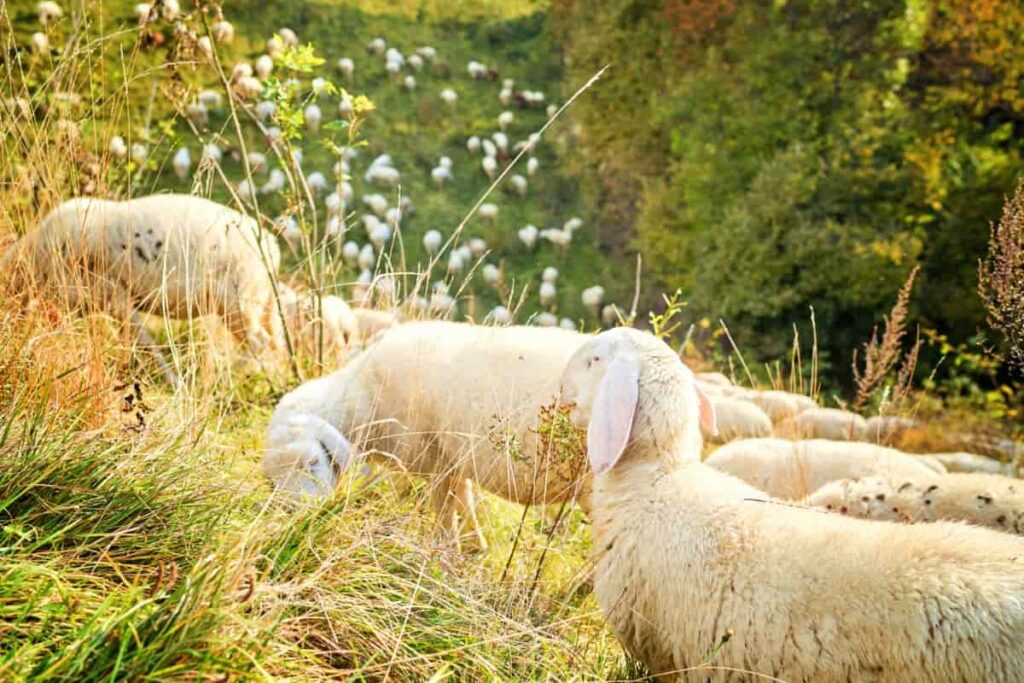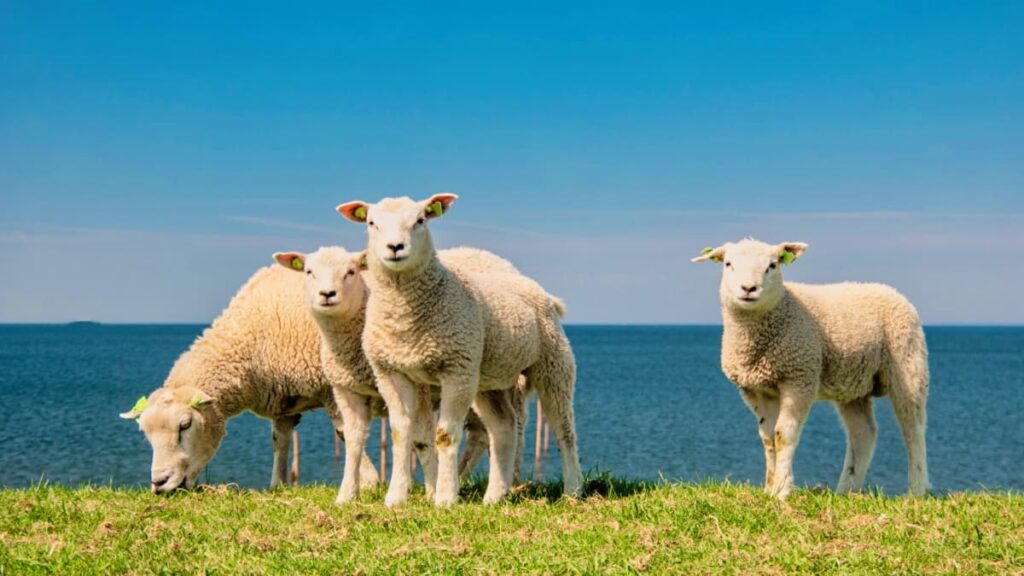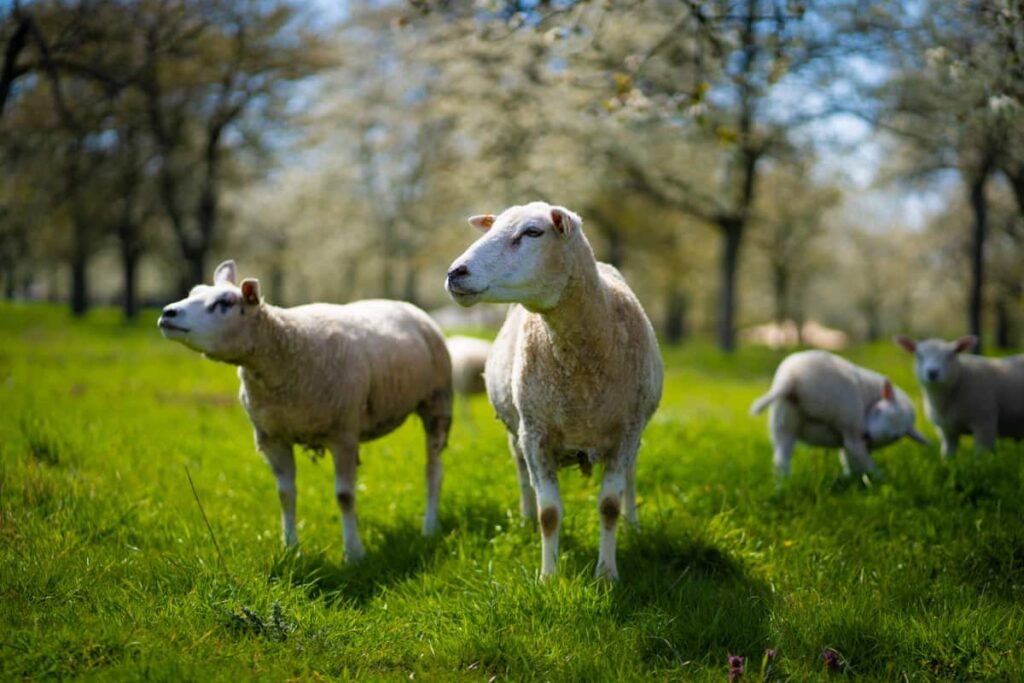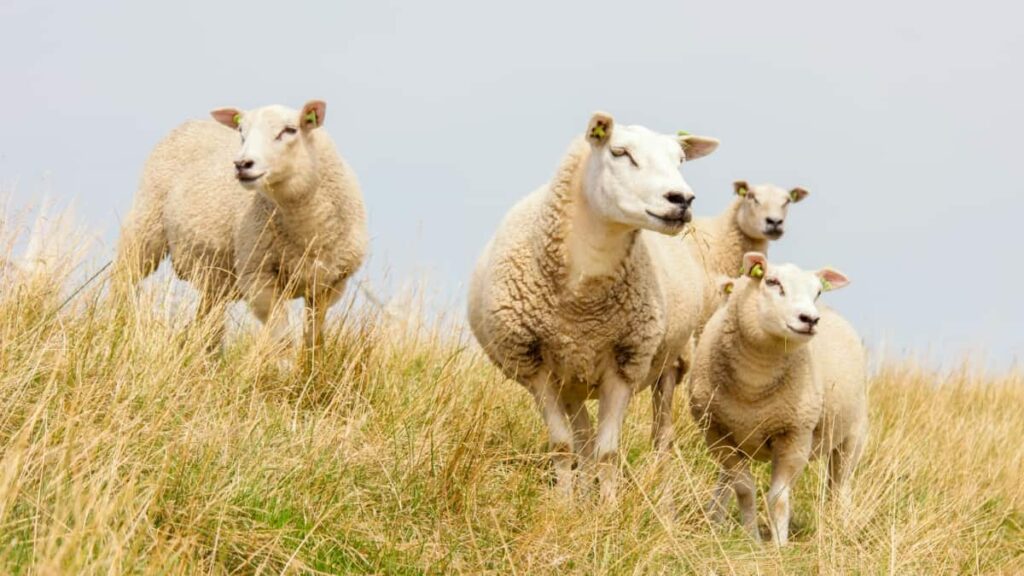Texel sheep are known for their exceptional meat quality, prized by many for their tenderness and flavor. This makes them a lucrative option for those in the livestock industry. Texel sheep are among the most commonly raised sheep in the commercial sector worldwide.

Raising Texel Sheep
History and Origin
Texel sheep, originating from the Dutch island of Texel, boast a rich history and distinctive characteristics. This breed is renowned for its heavy and muscular build, making it ideal for lean meat production. Texels also have excellent maternal instincts, ensuring strong lamb survival rates and reducing the need for intensive interventions during lambing season.
Breed Characteristics and Identification
With distinctive white faces and bare heads and legs, Texels stand out in the flock. Weighing an average of 95 kg for males and 75 kg for females, they are among the heavyweights in the sheep world. Standing at around 70 cm for males and 68 cm for females, these sheep may be compact but pack a punch to commercial farming.
Identifying Texel sheep is quite straightforward due to their unique features, such as broad frames, muscularity, and clean faces. These attributes contribute to their reputation as one of the most sought-after breeds in the agriculture industry today.
Breed Profile: Understanding Texel Sheep
Physical Traits
These sheep are known for their heavy and muscular build, with a distinct lack of wool on the head and legs. The Texel breed originated in Holland and is named after Texel Island off the North Sea coast.
Behavioral Traits
In terms of behavioral traits, Texel sheep are recognized for being hardy and adaptable animals. They exhibit a calm demeanor and have excellent maternal instincts when it comes to caring for their young. Their docile nature makes them easier to handle compared to other breeds. Understanding both the physical and behavioral characteristics of Texel sheep is crucial for successful farming practices.
The Economic Value of Raising Texel Sheep
Meat Production Qualities
When it comes to the economic value of raising Texel sheep, farmers can benefit from their exceptional meat production qualities and wool characteristics. Texel sheep are known for producing lean and flavorful meat carcasses that cater to the demands of the market. Their muscular build contributes to a high meat-to-bone ratio, making them an excellent choice for those focusing on quality meat production.
Wool Characteristics
Texel sheep also offer valuable wool characteristics. Their dense and heavy fleece is highly sought after in textile industries for its softness and durability. The wool from Texel sheep can be used in various products ranging from clothing to blankets, adding another revenue stream for farmers who raise these versatile animals. The dual-purpose nature of Texel sheep makes them a profitable investment for farmers looking to maximize their returns through both meat production and wool harvesting.
Housing and Shelter for Texel Sheep
Designing a Sheep Barn
Designing a sheep barn that offers protection from the elements and enough space for the flock to move around comfortably is essential. The shelter requirements for Texel sheep vary across seasons – from ensuring adequate ventilation during hot summer months to providing insulation and warmth in winter.
Shelter Requirements Across Seasons
A well-designed sheep barn should have good drainage to prevent moisture, which can lead to health issues for the animals. Adequate lighting is also important for the overall welfare of the flock, as natural light helps regulate their internal clock and behavior patterns. Texel sheep are hardy animals but still need protection from extreme weather conditions. By investing in a well-planned shelter setup that considers their seasonal needs, you can ensure your Texel sheep thrive year-round on your farm.
In case you missed it: Valais Blacknose Sheep: Raising Facts, Profile, Characteristics, and Care

Nutrition and Feeding
Basic Nutritional Needs
Texel sheep, like all livestock, require a well-balanced diet to thrive. Providing them with high-quality forage and clean water is essential for their optimal growth. Their basic nutritional needs include a mix of grass, legumes, grains, and mineral supplements.
Feeding Strategies for Optimal Growth and Health
Feeding strategies play a crucial role in ensuring the overall well-being of Texel sheep. It’s important to establish a feeding routine that meets their energy requirements at different stages of life. Gradually introducing new feeds and monitoring their intake helps prevent digestive issues. Contact with a veterinarian can help tailor a feeding plan specific to your flock’s needs. Regularly assessing body condition scores can also guide you in fine-tuning your diet for optimal health outcomes.
Health Management
Common Health Issues and Prevention
Texel sheep, like any other livestock, are affected by various health problems that can impact their overall well-being. Common health concerns for Texel sheep include parasitic infections, foot rot, and respiratory diseases. To ensure the health of your flock, it is crucial to implement a proactive approach to disease prevention.
Vaccination and Deworming Schedule
Vaccinations play a vital role in protecting Texel sheep from diseases such as foot-and-mouth disease and clostridial infections. Establishing a regular vaccination schedule in consultation with a veterinarian is essential for maintaining the health of your herd. In addition to vaccinations, deworming is another critical aspect of health management for Texel sheep.
Internal parasites can wreak havoc on the digestive system of sheep if left untreated, leading to weight loss and poor overall condition. By staying vigilant about common health issues and following recommended vaccination and deworming protocols, you can safeguard the well-being of your Texel sheep herd for years to come.
Reproductive Management
Breeding Age and Selection
When it comes to Texel sheep, reproductive management plays a main role in maintaining a healthy and sustainable flock. Breeding age and selection are key factors in ensuring the genetic diversity and overall quality of the offspring. Ewes should be bred for the first time at around 8-12 months old to support their physical development.
Care of Ewes During Pregnancy and Lambing
During pregnancy, ewes require proper care and nutrition to ensure the health of both the mother and her lambs. Adequate feeding, access to clean water, regular veterinary check-ups, and appropriate shelter are essential during this critical period. Lambing season is an exciting yet challenging time for sheep farmers.
It is vital to provide ewes with a comfortable and safe environment for giving birth. Monitoring them closely during labor can help identify any potential issues early on. By prioritizing breeding age, selection processes, prenatal care, and attentive lambing practices, you can set your Texel sheep flock up for success.
Lamb Rearing
Initial Care and Management of Lambs
Lamb rearing is a crucial aspect of Texel sheep farming, requiring attention to detail from the start. When it comes to the initial care and management of lambs, providing a warm and clean environment is key for their health and growth. Ensuring they receive adequate colostrum within the first few hours of birth boosts their immunity.
Weaning and Growth Monitoring
Weaning is another significant milestone in lamb rearing, typically done around 2-3 months of age. It’s essential to transition them gradually onto solid feed while monitoring their weight gain and overall health during this period. Growth monitoring plays a vital role in assessing the development of Texel lambs. By carefully managing these aspects, farmers can raise healthy Texel lambs ready for market or breeding purposes.
In case you missed it: Dorper Sheep Farming in Kenya: Raising From Scratch for Breeding to Marketing

Wool and Meat Processing
Shearing Techniques and Wool Handling
Shearing Texel sheep is a crucial annual task that ensures their well-being and the quality of their wool. Proper shearing techniques are essential to avoid causing any harm to the sheep while efficiently removing their fleece. The wool collected from Texel sheep is highly prized for its softness and durability, making it sought after in various textile industries.
Slaughter, Processing, and Marketing Meat
After shearing, the wool goes through a meticulous cleaning and sorting process to prepare it for spinning or felting. Texel sheep also provide high-quality meat with excellent taste and tenderness. Marketing plays a crucial role in connecting Texel meat products with interested buyers who value premium quality and ethical farming practices.
Sustainability and Ethical Practices
Environmental Stewardship in Texel Sheep Farming
Texel sheep farming goes beyond just raising livestock; it’s about embracing sustainability and ethical practices. As stewards of the environment, Texel sheep farmers implement strategies to minimize their ecological footprint. From pasture rotation to waste management, every decision is made with the planet in mind.
Ethical Considerations in Breeding and Production
Ethical considerations are also paramount in breeding and production. Responsible breeding practices ensure the health of the flock, prioritizing genetic diversity and disease prevention. By upholding high standards of animal welfare, Texel sheep farmers create a harmonious balance between productivity and compassion.
In case you missed it: Sheep Milk Production: Lactation Period, Uses, Benefits, Price, and Dairy Sheep Breeds

Conclusion
Texel sheep farming holds significant importance in the agricultural sector for various reasons. Additionally, Texel sheep have excellent wool characteristics, adding to their economic value. By raising Texel sheep, farmers can diversify their livestock operations and tap into profitable markets.
Note: The images presented in this post are intended solely for representation purposes. The images are meant to serve as visual aids and should not be relied upon as accurate representations of their real-life counterparts.
- Profitable Village Farming Business Ideas in 2024
- High-Yield Aquaculture: Fast-Growing Fish for Farming
- Effective Fish Pond Construction Techniques for Beginners
- Irrigation and Water Management in Pineapple Farming
- Blossom to Harvest: Mastering Flowering and Pollination in Papaya Farming
- Pig Fattening Essentials: From Selection to Sale for Beginners
- Raising Wagyu Cattle: A Complete Guide for Premium Beef Production
- Soil Types and Their Water Holding Capacity
- Optimizing Irrigation Schedules for Coconut Groves for Enhanced Yield
